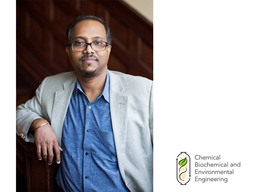Department Seminar: Dr. Dipanjan Pan
Trends in Nanomedicine: Are we there yet?
Location
Engineering : 027
Date & Time
September 16, 2019, 12:00 pm – 1:00 pm
Description
Please join us for the first CBEE seminar of Fall 2019 presented by our newest member of the faculty, Dr. Dipanjan Pan
Trends in Nanomedicine: Are we there yet?
Dipanjan Pan, PhD, FRSC, FAHA, FACC
Professor of Radiology and Chemical, Biochemical & Environmental Engineering
Director, Imaging Probe Development & Characterization Resources, Radiology
Director, Nano-fabrication & Characterization Core, CBO2TH
University of Maryland Baltimore County & University of Maryland Baltimore SOM
Key words: nanomedicine, drug discovery, drug delivery, molecular imaging, biosensing
Nanoscale structures offer unprecedented potential in pre-emptive medicine covering early detection, diagnosis and therapy of diseases. This talk will address the promise and perils in nanomedicine and introduce defined approaches for next generation particles that completely ‘disappears’ from body. Pan Lab@Illinois (and now @UMaryland) advances translatable technologies for human health by uniquely merging ‘molecule making’ and ‘device making’ through innovations in molecular imaging, point-of-care biosensing9-12 and machine learning tools. We will briefly introduce novel multi-color, ‘luminescence switachable’ carbon nanodots developed in our laboratories and highlight seminal results from preclinical imaging1-4 studies, e.g. targeting angiogenic sparse biological epitopes, microbiota detection and treatment strategies for hemorrhagic shock or cancer stem cells5-8.
In the later part of the talk we will discuss an antibiotic-free approach for topical eradication of dental biofilm without disturbing microbiota balance. Biofilms are the major cause of dental caries and many systemic diseases which compromise the quality of life and incur economic cost. Current clinical treatments are rendered ineffective due to non-specificity towards commensal bacteria with the potential of introducing resistance. We will discuss how we overcame this problem by a drug-free approach which employs the pathological pH of biofilm to trigger release of therapeutic carbon nanodots from a polymer shell in a stimuli-responsive manner. Importantly, our results will highlight that these agents did not alter the ecological balance of oral microbiota providing a safe strategy barring any additional antibiotics.
References
- Adv. Funct. Mater. 2019, 1902466.
- ACS Nano. 2019, 13(7):7690-7704.
- J Am Chem Soc. 2017; 139(5):1746-1749.
- Adv. Funct. Mater. 2016; 26: 8031-8041.
- Proc Natl Acad Sci U S A. 2018; 115(32): 8087-8092.
- J Med Chem. 2018; 61(23):10739-10752.
- Biomaterials. 2018; 181:252-267.
- Mol Cancer Ther. 2018; 17(1):119-129.
- Biosens Bioelectron. 2018; 120:77-84.
- Biosens Bioelectron. 2018; 110:132-140.
- Anal Chem. 2017; 89(3):2107-2115.
- Sci Rep. 2015; 5:16011.
